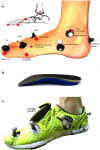The Foot's Arch and the Energetics of Human Locomotion
- PMID: 26783259
- PMCID: PMC4726102
- DOI: 10.1038/srep19403
The Foot's Arch and the Energetics of Human Locomotion
Abstract
The energy-sparing spring theory of the foot's arch has become central to interpretations of the foot's mechanical function and evolution. Using a novel insole technique that restricted compression of the foot's longitudinal arch, this study provides the first direct evidence that arch compression/recoil during locomotion contributes to lowering energy cost. Restricting arch compression near maximally (~80%) during moderate-speed (2.7 ms(-1)) level running increased metabolic cost by + 6.0% (p < 0.001, d = 0.67; unaffected by foot strike technique). A simple model shows that the metabolic energy saved by the arch is largely explained by the passive-elastic work it supplies that would otherwise be done by active muscle. Both experimental and model data confirm that it is the end-range of arch compression that dictates the energy-saving role of the arch. Restricting arch compression had no effect on the cost of walking or incline running (3°), commensurate with the smaller role of passive-elastic mechanics in these gaits. These findings substantiate the elastic energy-saving role of the longitudinal arch during running, and suggest that arch supports used in some footwear and orthotics may increase the cost of running.
Figures




References
-
- Cavagna G. A., Heglund N. C. & Taylor C. R. Mechanical work in terrestrial locomotion: Two basic mechanisms for minimizing energy expenditure. Am J Physiol Regulatory Integrative Comp Physiol 233, 243–261 (1977). - PubMed
-
- Blickhan R. & Full R. J. In Biomechanics (structures): A practical approach (ed Biewener A.) 75–96 (Oxford University Press, 1992).
-
- Alexander R. M. Elastic energy stores in running vertebrates. Am Zool 24, 85–94 (1984).
-
- Ker R. F., Bennett M. B., Bibby S. R., Kester R. C. & Alexander R. M. The spring in the arch of the human foot. Nature 325, 147–149 (1987). - PubMed
MeSH terms
LinkOut - more resources
Full Text Sources
Other Literature Sources

